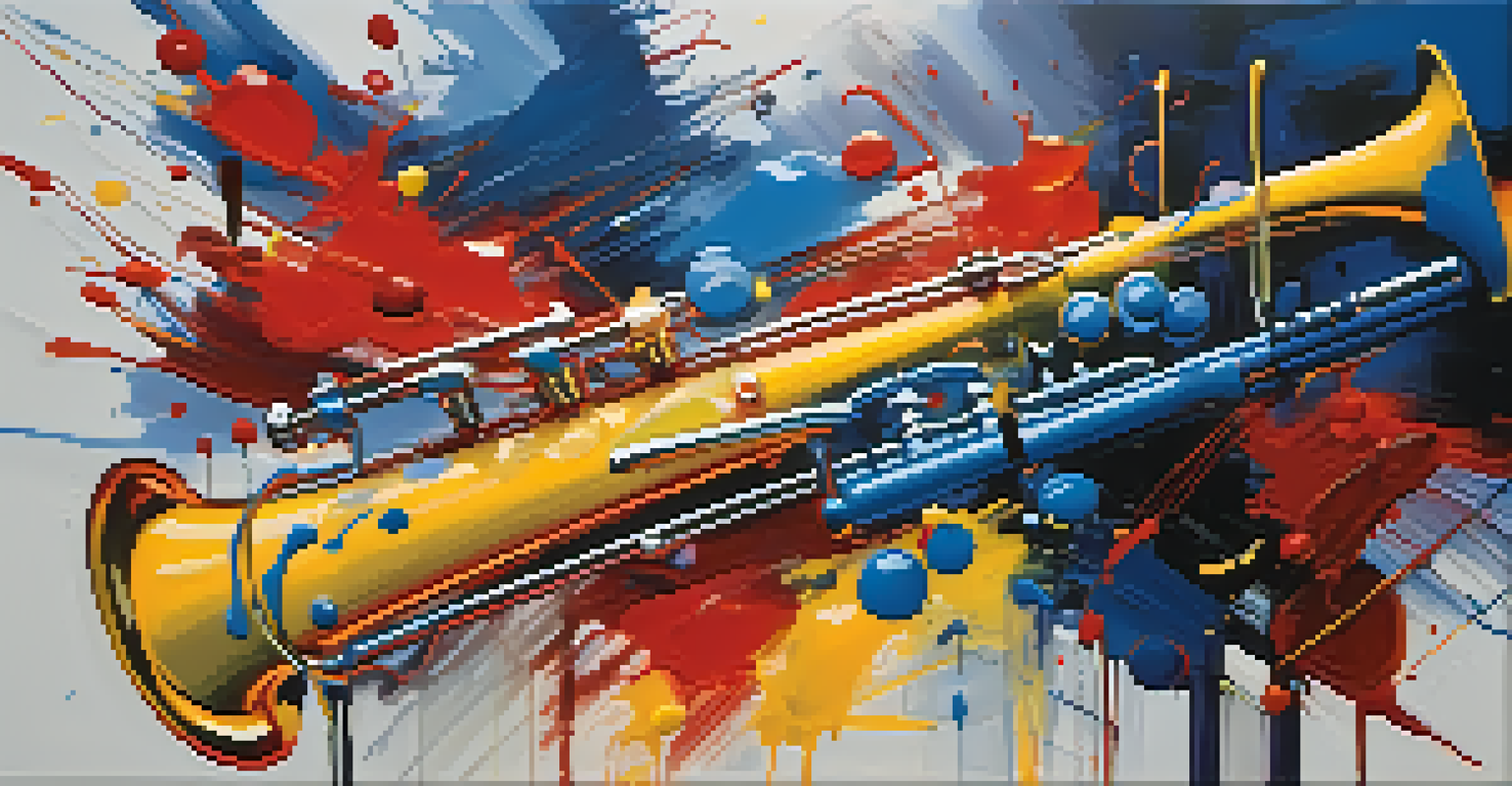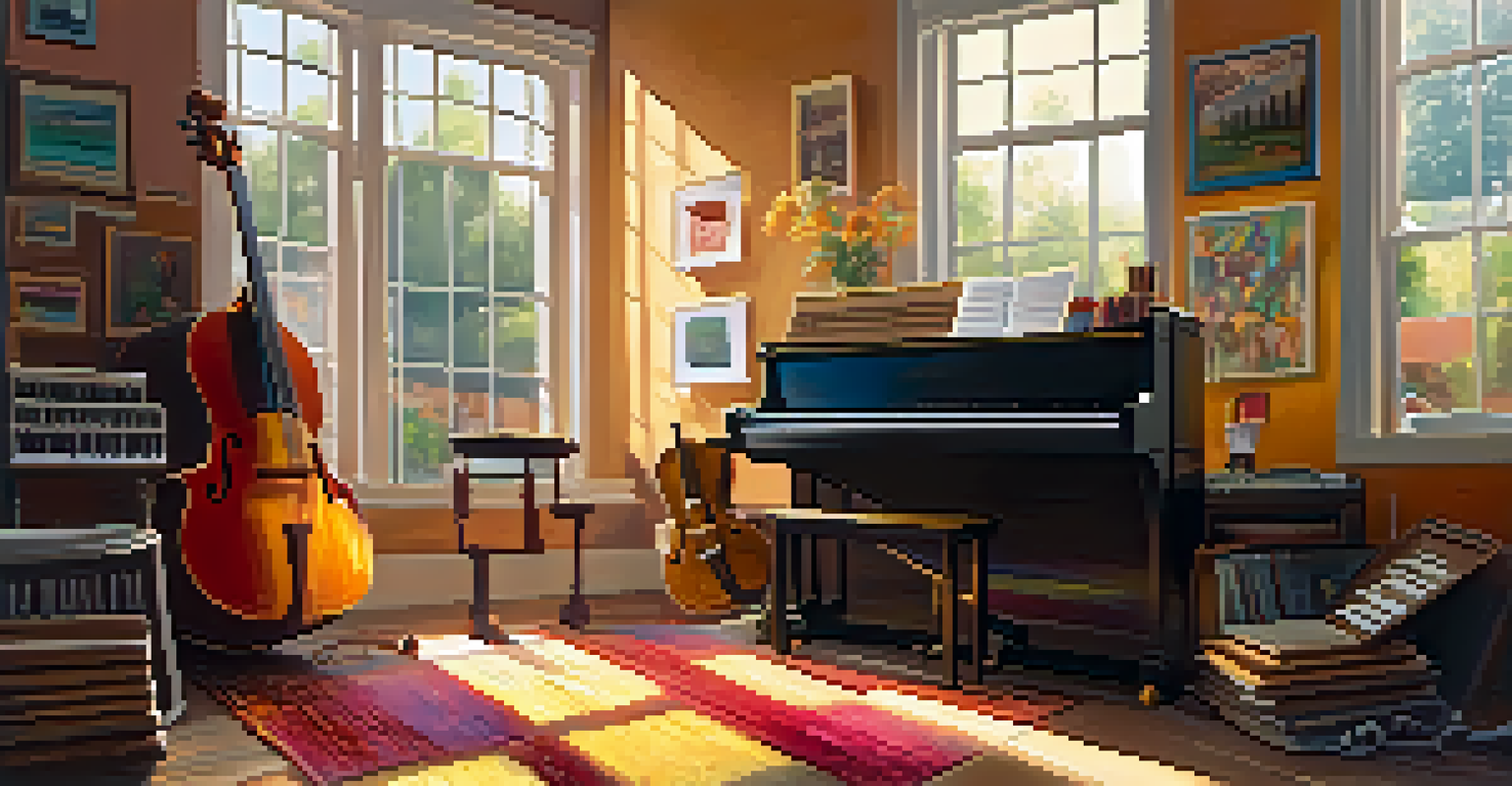The Emotional Resonance of Music in Artistic Expression

Understanding the Emotional Impact of Music
Music has a unique ability to evoke emotions that words often cannot express. From the triumphant crescendos of a symphony to the melancholic notes of a ballad, each piece can transport listeners to different emotional landscapes. This connection is rooted in our biology; studies show that music stimulates the release of neurotransmitters like dopamine, which plays a key role in how we experience pleasure.
Music can change the world because it can change people.
Consider a moment when a song brought you to tears or made you feel elated. These reactions are not just personal; they are universal. Different cultures may respond to music in varied ways, but the emotional core remains consistent, highlighting music's power to resonate with our shared human experience.
This emotional resonance is why music is a staple in film, theater, and visual arts. It enhances narratives, deepens character development, and creates an atmosphere that can linger long after the last note fades. In short, music serves as an emotional thread that weaves through artistic expression, enriching our understanding of the art form.
Music as a Tool for Artistic Expression
Artists often use music as a foundational element in their work, whether it's through choreography, visual arts, or literature. For instance, dancers frequently choreograph movements that align with the rhythm and mood of a piece, effectively telling a story through both sound and movement. This synergy allows for a multi-dimensional experience that captivates audiences on multiple levels.

Moreover, visual artists might listen to music while creating, allowing the sounds to influence their brushstrokes or color choices. Imagine an abstract painting inspired by a jazzy tune, where the spontaneity of the music translates into vibrant splashes of color. This interplay fosters a creative dialogue that can lead to unexpected and profound artistic outcomes.
Music Evokes Deep Emotions
Music has an unparalleled ability to evoke emotions, influencing our feelings and enhancing our experiences across various forms of art.
In literature, authors often draw on musical themes to deepen their narratives. A poignant scene might be underscored by references to a particular song that encapsulates the characters' emotions. This use of music not only enhances the storytelling but also establishes a connection with readers, making the experience more relatable and immersive.
Cultural Significance of Music in Art
Music is deeply embedded in cultural identities, often serving as a reflection of collective values and emotions. For instance, folk music can tell stories of a community's struggles and triumphs, connecting generations through shared experiences. This cultural resonance makes music an essential component of artistic expression, as it can preserve history and foster a sense of belonging.
Where words fail, music speaks.
Take the example of protest songs, which have historically united people in times of social change. These songs convey powerful messages and emotions, galvanizing communities around a common cause. The art of music in this context becomes a catalyst for change, highlighting the profound impact it can have on society as a whole.
As art evolves, so does the role of music within different cultures. Contemporary artists might blend genres or incorporate traditional sounds into modern works, demonstrating how music can bridge generational and cultural gaps. This evolution keeps the art form vibrant and relevant, emphasizing music's ongoing significance in cultural expression.
The Psychological Benefits of Music in Art
Engaging with music, whether as a creator or a listener, offers numerous psychological benefits. It can act as a form of therapy, providing an outlet for emotions that might otherwise remain unexpressed. Many artists find solace in music, using it as a means to navigate their own emotional landscapes while creating art that resonates with others.
For instance, art therapy often incorporates music to help participants explore their feelings and experiences. This combination allows individuals to express themselves in ways that transcend traditional verbal communication. The result is a profound healing process, demonstrating how music can facilitate emotional exploration within artistic practices.
Art and Music Interconnect
Artists often blend music with visual arts and literature, creating multi-dimensional experiences that deepen emotional connections with their work.
Moreover, studies have shown that creating music can reduce anxiety and depression, promoting overall well-being. Artists who integrate music into their creative process often report heightened feelings of joy and satisfaction, underscoring the positive psychological impact of merging music with artistic expression.
The Role of Music in Storytelling
Storytelling is a fundamental aspect of both music and other forms of art, with music enhancing narratives in captivating ways. A well-placed soundtrack can amplify the emotional stakes of a scene, guiding the audience's feelings and responses. Think of how a suspenseful score elevates the tension in a film; it’s a perfect example of music’s ability to shape our understanding of a story.
In literature, authors might weave musical elements into their narratives, using rhythm and sound to convey mood or tone. This can create a more immersive experience for readers, as they can almost 'hear' the music playing in their minds. By incorporating music into storytelling, artists can evoke specific emotions, making their narratives more engaging and relatable.
Additionally, the use of music in theater or dance brings stories to life in ways that are visually and aurally stimulating. Performers interpret the music through their movements, creating a dynamic interplay between sound and action. This synergy not only captivates audiences but also deepens their emotional connection to the story being told.
The Interplay Between Music and Visual Arts
The relationship between music and visual arts is a fascinating one, as both forms can influence and enhance each other. Many artists draw inspiration from music when creating visual works, interpreting sounds into colors and shapes. This process can lead to stunning pieces that visually represent the emotions conveyed through music.
For instance, notable artists like Wassily Kandinsky believed that colors could be associated with musical notes, creating a synesthetic experience for viewers. His abstract compositions were often inspired by music, showcasing how sound can shape visual expression. This interplay invites audiences to experience art in a multi-sensory way, deepening their understanding and emotional response.
Music's Cultural Significance
Music reflects cultural identities and values, serving as a powerful tool for storytelling and social change throughout history.
Moreover, installations that incorporate music create immersive environments where spectators can feel the art around them. Imagine walking through a gallery where each piece is accompanied by a carefully curated soundtrack, enhancing the atmosphere and emotional weight of the artwork. This fusion of music and visual art broadens the horizons of artistic expression, offering a richer experience for audiences.
Looking Ahead: The Future of Music in Artistic Expression
As technology continues to evolve, so does the landscape of music and artistic expression. With advancements in digital media, artists now have unprecedented access to create and share their work across various platforms. This shift encourages experimentation, allowing musicians and visual artists to collaborate in innovative ways that challenge traditional boundaries.
For example, virtual reality experiences can immerse users in worlds where music and visual art coexist, creating interactive experiences that were once unimaginable. These advancements not only enhance artistic expression but also invite audiences to engage with art in more meaningful ways, redefining how we appreciate and interact with creative works.

Looking ahead, the fusion of music and art will likely continue to evolve, reflecting cultural shifts and technological advancements. As artists explore new mediums and forms of expression, the emotional resonance of music will remain a vital component, reminding us of its power to connect us to ourselves and to one another in profound ways.